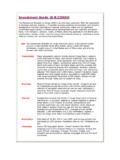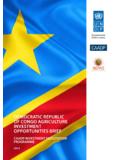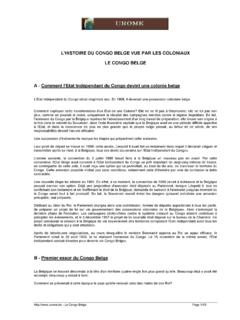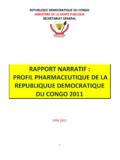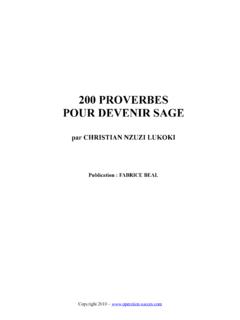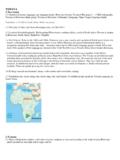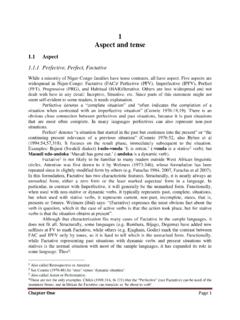Transcription of Congolese refugees - UNHCR
1 Congolese refugees A protracted situation As of 1 January 2014,1 almost half a million refugees had fled the Democratic Republic of congo (DRC) making the DRC refugee population the sixth largest in the world. Various conflicts since the 1960s have created Congolese refugees , and refugees from the DRC now represent 18 per cent of the total refugee population in Africa. Among the 455,522 Congolese refugees registered in Africa as of 1 January 2014, some 50 per cent (225,609 persons) are in the Great Lakes Region, approximately 39 per cent (177,751 persons) are in the East and Horn of Africa, and 11 per cent (52,162) are in the Southern Africa region.
2 In Burundi and Rwanda, Congolese refugees represent over 99 per cent of the total registered refugee population. In Tanzania and Uganda, Congolese refugees represent approximately 65 per cent of the total registered refugee population. Despite the conclusion of Tripartite Agreements,2 continuous instability in eastern DRC, fuelled by armed conflict and ethnic tensions, prevents refugees from returning. While their situation in the host countries differs, achieving a durable solution in the form of local integration continues to be a challenge for most Congolese refugees .
3 Large numbers of Congolese refugees continue to live in restricted camp environments, heavily dependent on international aid with their populations steadily increasing due to births and new arrivals. Due to the size and the protracted nature of the Congolese refugee situation and the on-going violence in eastern DRC, a common sub-regional approach to enhance durable solutions for Congolese refugees within a comprehensive solutions strategy was introduced in early 2012. This strategy includes significantly increased resettlement of Congolese refugees who are living in a protracted situation in the Great Lakes and Southern Africa region.
4 In order to implement the resettlement strategy in a regionally harmonized manner and taking into account reservations towards resettlement, such as pull factors and processing capacity, refugees considered for resettlement are being profiled according to two main criteria: Arrival in country of asylum from 1 January 1994 to 31 December 2005; Province of origin/ last residence must be North Kivu, South Kivu, Katanga or Province Out of the approximately half a million Congolese refugees in the region, an estimated 160,000 refugees fulfil these two criteria.
5 It is planned that a total of at least 50,000 Congolese refugees will be submitted for resettlement from 2012 to 2017 from the four main host countries Burundi, Rwanda, Tanzania and Uganda. 1 All sta s cs in this document are based on the 2013 UNHCR Annual Sta s cal Report (ASR) and the 2013 Rese lement Sta s cal Report (RSR). 2 Tripar te Agreements DRC/ UNHCR and Tanzania signed in 2005, with Burundi in 2009, with Rwanda and Uganda in 2010. (Uganda agreed it would start to assist spontaneous returns with transport to prevent refugees from taking dangerous travel routes resul ng in tragedies similar to the one in March 2014 where 250 DRC refugees perished when their boat capsized on their way back home).
6 3 This was agreed during the Regional Representa ves mee ng of Central Africa and the Great Lakes on 28/29 March 2012 with a follow-up mee ng in Nairobi on 21/22 May to consolidate a mul -year ac on plan . Situation overview 2 Priority Situation Fact Sheet Restricted distribution Profile of Congolese refugees In Burundi, Congolese refugees originate mainly from Katanga and South Kivu Province, whereas in Rwanda, Congolese refugees come almost exclusively from North Kivu. In Tanzania, the majority originate from South Kivu and in Uganda mostly from North The majority of refugees currently in Rwanda and Tanzania fled in 1996, with a second peak to Tanzania in From 2002 to 2005, there were constant but substantial arrivals in all four countries, with a considerable increase in Uganda.
7 The majority of Congolese refugees are of Banyarwanda background (Tutsi, Hutu or Banyamulenge). The remaining Congolese refugee populations have a large variety of different ethnic backgrounds. The majority of the DRC refugee population is under the age of 18. Household size is estimated to be on average five individuals for the protracted population. Considerable numbers of Congolese refugees have not received any formal They speak a variety of languages, though Kinyarwanda and Kiswahili is mostly French is spoken more commonly than English, however, in English speaking host countries, French skills are being The majority of the Congolese refugees work in agriculture.
8 The refugee population consists of comparatively large numbers of single parents/single mothers, persons with medical needs, including various trauma and SGBV survivors, and unaccompanied or separated children. Given the profiles of many refugee women and last year s submissions, the target of submitting at least 10 per cent women at risk cases should easily be exceeded. In 2012 / 2013, Burundi submitted 38/ 30 per cent women at risk, Rwanda 24 per cent, Tanzania 20/ 31 per cent and Uganda 23/ 27 per cent respectively.
9 Situation in country of asylum Most of the Congolese refugees from eastern DRC reside in camps or settlements in the Great Lakes and Southern Africa region, most often in protracted situations, and many of them for over 17 years. As of 1 January 2014, the 45,124 registered Congolese refugees in Burundi live in the urban centre of Bujumbura (37 per cent), the camps of Kinama (21 per cent), Bwagiriza (20 per cent), Musasa (15 per cent) and Kavumu (7 per cent). The 72,988 registered Congolese refugees in Rwanda live in the camps of Kiziba (22 per cent), Nyabiheke (19 per cent), Gihembe (19 per cent), the new camps Kigeme (24 per cent), Mugumobwa (9 per cent), and in the urban centre Kigali (2 per cent).
10 The 64,569 registered Congolese refugees in Tanzania live in Nyarugusu camp in the north west of the country, close to the town of Kasulu. Among the 155,742 Congolese refugees in Uganda, 88 per cent live in settlements and 12 per cent live in the urban centre Kampala. Out of the overall Congolese population, the protracted Congolese refugee population, which arrived between 1994 and 2005, is mostly residing in the older settlements Kyaka II (39%) , Kyangwali (35%), Nakivale (6%) as well as in urban Kampala (20%). Most of the Congolese refugees have been recognized by host Governments on a prima facie basis.










